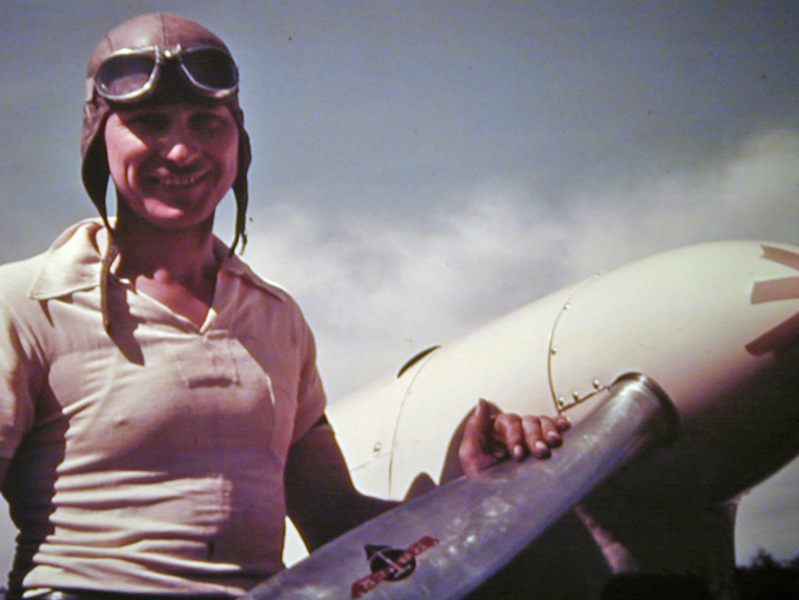
• Influential designer & pilot in 1930s and ‘40s
• Greve Trophy winner at 1939 National Air Races
• Set a world speed record at 237 mph
• In WWII, led engine installation for P-51 Mustang
• 1st president of Professional Race Pilots Association
• Built the foundation for today’s Formula 1
• Named his planes after Popeye cartoon characters
He designed and raced some of the most successful planes of the ‘30s, then helped create the fighter that turned the tide in WWII. Chester rose to prominence winning the 1930 National Air Races, then designed and built his own planes named after Popeye characters, the Chester Jeep, Goon and Swee’ Pea. Starting with the 1933 National Air Races, the Jeep won major races over several seasons, and once held the world speed record at 237 mph. In 1936, Chester was hired to help develop the Menasco Pirate and Buccaneer inverted inline racing engines. Piloting the Goon, Chester won the prestigious Greve Trophy at the 1939 National Air Races at 263 mph. In WWII, he led engine installation for the P-51 Mustang. As the Professional Race Pilots Association’s first president, Chester was an early promoter of midget racing, which in 1947 became today’s Formula 1. His final design, Swee’ Pea, debuted at the 1947 National Air Races. Chester died in Swee’ Pea II at the San Diego Air Races two years later.
By Tim Weinschenker
Art Chester was a man of many talents. He was made famous by his exploits in his “Cast of Characters,” a group of custom-designed and -built race planes named after the characters from the “Popeye the Sailor” cartoon strip. In the 1930s it was “Jeep” and “Goon” that he would fly to race victories in the National and Regional Air Races of “The Golden Age of Air Racing.” After World War II these two were replaced by “Swee’ Pea I and II” and “Wimpy.” It was in 1949 that his life would be cut tragically short at the age of 50 when he crashed to his death in a regional air race in San Diego, California, leaving behind his wife Trudy and son Tommy and a legacy in the sport of air racing that lives on today. It was actually the work that Art did behind the scenes, on the organization and promotion of the sport of air racing, that ensured his legacy would live on for generations.
Chester was born in Illinois in 1899. He had an appreciation for all things mechanical and a love of aviation during his formative years. It was in 1929 that the National Air Races in Cleveland began, and it was in that year that Art began to compete in closed-course pylon events on both a national and regional level. In later years, Art would tell the press that he learned how to race “the hard way” by following others around the course during a race. By 1932 he was no longer content to follow others and constructed the first of his “cast of characters.” This was the “Jeep” that was powered by a supercharged Menasco engine.
It was not long before Art was winning races and learning the mechanical intricacies of the inverted 4-cylinder engine to the point that Al Menasco hired Art to be the chief tester of his engine company.
It was during this period that Art briefly contemplated retirement from the sport to concentrate on engine testing, but the lure of competition could not be overcome.
Art was what some would call a “backyard engineer.” He had no formal schooling but was blessed with a natural ability to create a design and then fabricate it in the materials needed to turn that design into reality. National pride spurred him to create “The Goon” in response to the domination of the 1936 National Air Races by Frenchman Michael Detroyat in his Caudron. “The Goon” brought Art increasing fame and fortune when he was able to win the Greve Trophy race at the 1939 National Air Races.
World War II saw Art use his natural engineering ability at North American Aviation where he would contribute to the design of the famed P-51 Mustang fighter that helped win the war. After hostilities ceased, his legacy in the sport of air racing would be secured by his vision of a new class of “midget” racers. This class, now called Formula One, still competes today at the National Air Races.
A fitting tribute to this talented man of vision and skill in the sport of air racing.
Weinschenker is the Golden Pylons editor for Challenge Publications and President of the Society of Air Racing Historians. His articles have appeared in Air Classics, Warbirds Worldwide, Mustangs International and Aeroplane. He is currently working on a complete history of the Bendix and Thompson Trophy races.
Dr. Tim Weinschenker
(Mike Meadows)